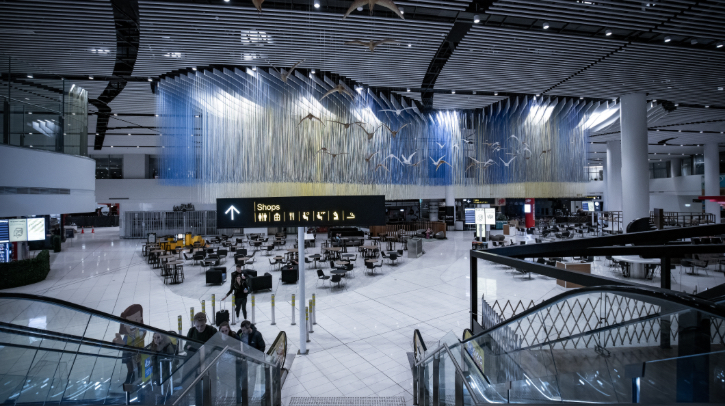The New Zealand Commerce Commission has published its final report on Auckland Airport’s 2022-2027 price-setting event (PSE4), concluding the airport’s forecast revenue is excessive and its targeted returns are unreasonably high, but its forecast investment falls within a reasonable range. Auckland Airport has said in response that it will discount its prices for airline passenger charges. The International Air Transport Association (IATA) has called for urgent changes to New Zealand’s economic regulatory framework for airports.
New Zealand’s regulatory context
Auckland, Christchurch and Wellington are subject to information disclosure regulation under Part 4 of the Commerce Act. The regulation is intended to improve the transparency of each airport’s performance around profits, investment, pricing and service levels – and determine if the airport’s pricing decisions and expected performance promote the long-term benefit of consumers.
The commission does not set the prices charged by the three airports. Under the Airport Authorities Act 1966, the airports set prices as they see fit, but are required to consult substantial customers, like airlines, on charges and any major capital expenditure plans.
On trial: Auckland Airport’s investments
Among Auckland Airport’s projects is a new domestic terminal to replace the almost 60-year-old existing domestic terminal building. Integrated with the international terminal, the airport has stated it will improve service quality and customer experience, especially for transit passengers, and provide capacity for long-term growth in passenger numbers. Specifically, Auckland Airport’s new domestic jet terminal is expected to deliver 26% more domestic seat capacity, 44% more processing capacity, and open the door to more competition in the domestic aviation sector.
The integrated terminal program is now 31% advanced and the project employs over 1,000 people. The airport is also progressing with critical airfield upgrades that are essential to the future resilience and safety of the airfield. The runway needs to close temporarily in about 2030 for planned pavement maintenance. The closure is to allow enlarging a taxiway so it can be used as an alternative runway, as well as the opening of the new domestic jet terminal in 2029, providing domestic jets with a new home to operate from.
Carrie Hurihanganui, chief executive of Auckland Airport, said, “New Zealand generally has had a chronic shortage in infrastructure investment for decades, and this clearly isn’t working for Aotearoa. We are really heartened that today the commission confirmed Auckland Airport is investing at a reasonable level to ensure the future resilience of New Zealand’s gateway airport – one of our country’s most critical infrastructure assets. New Zealand is actively seeking foreign investment into infrastructure, and a reasonable rate of return and stable regulatory settings are going to be critical for our country in this endeavor.”
“Airports that we compete with to attract airlines, tourism and freight are all investing at a similar scale to us and New Zealand cannot afford to fall behind. Major Australian airports have also announced investment plans that for each individual airport are worth over A$5bn (US$3.4bn), which is approximately NZ$5.5bn (US$3.8bn).”
Commerce Commission’s assessment
In setting out its final conclusions for Auckland Airport’s pricing decisions for the five-year period running from 1 July 2022 to 30 June 2027, the commission assessed material and inputs relating to profitability, investment plans, pricing efficiency and innovation.
Vhari McWha, commissioner at the Commerce Commission, said, “The airport is targeting an excess profit of about NZ$190m [US$110m] and its charges are too high, with businesses and consumers likely to end up carrying much of the cost burden.”
According to the Commerce Commission, the excess profit represents a targeted return of 8.73% from priced aeronautical activities – for example, aircraft landing and passenger terminal charges – compared to the commission’s estimated reasonable return of between 7.3% and 7.8%.
“Price increases will fund investment needed to improve customer experience, build more resilient infrastructure and add additional capacity, but the increases are higher than what is needed to achieve these outcomes,” said McWha.
When it comes to costing its investment plan, McWha stated the airport followed appropriate processes. She said, “While views on the type, size and timing of the investment differ among the airport’s customers, our analysis shows Auckland Airport engaged multiple third-party experts to assist with costing its investment plan and considered a wide range of options for its new terminal building.
“There are a range of investment outcomes that are consistent with what we’d expect to see in a competitive market. This range reflects uncertainty about future demand and choices about factors such as service quality. We are satisfied that Auckland Airport’s decision is within this range.”
The commission also concluded that a different approach to recovering depreciation of the new terminal infrastructure would better serve consumers’ interests. Depreciation refers to how capital investment is recovered through airport charges over time. This approach would lower charges in the short term and be more consistent with outcomes in a competitive market. The commission’s final conclusions are largely in keeping with its draft conclusions, which were published in July last year.
Auckland Airport’s response
The airport has said it will take on board feedback from the report on the airport’s approach to PSE5 and PSE6 pricing. This includes considering methods to smooth long-term prices, an issue that had already been discussed with airline customers as part of the PSE4 consultation.
In particular, Auckland Airport has confirmed it will discount its prices for airline passenger charges. Over the next two financial years, Auckland Airport will discount per passenger airline charges on an average basis by about NZ$1.10 (US$0.64) for regional travel to NZ$9 (US$5.22); NZ$1.70 (US$0.99) for domestic jet travel to NZ$12.80 (US$7.42); and NZ$4.80 (US$2.78) for international travel to NZ$38.90 (US$22.54). The updated charges, which are for airlines’ use of the airfield and other essential airport services, represent a new targeted return of 7.82% (down from 8.73%) overall for PSE4, in line with the range considered reasonable by the Commerce Commission.
Hurihanganui continued, “We respect the regulator’s findings and since receiving an embargoed copy of the report, we have worked to apply price discounts for the remainder of the pricing period. These discounts will bring our prices within the range the Commerce Commission found to be reasonable.
“Auckland Airport carefully balances how we set charges with the need to invest in the future resilience and capacity requirements of New Zealand’s gateway airport and one of the country’s most critical infrastructure assets. To support this, investors require fair returns and a stable regulatory regime.
“In July 2024, following the commission’s draft report, we said we would discount our charges if the commission’s final report took a different view on what a reasonable target return for PSE4 was, bearing in mind the challenges involved when incorporating new information about pandemic risk into the weighted average cost of capital (WACC). The airport’s decision to discount PSE4 prices demonstrates the regulatory regime working as it’s intended to.”
“The commission’s new approach to WACC is subject to a merits review appeal by all regulated airports and the New Zealand Airports’ Association, due to be heard in July 2025 in the High Court. While Auckland Airport has aligned its PSE4 target return with the commission’s target return range in the final report, the merits review remains important to resolve the differences in views on the best methods for estimating WACC,” she said.
International Air Transport Association’s reaction
The report also commented on the interests of airlines, highlighting that while they are a key customer group they do not always represent the views of other airport customers such as passengers, and that airline interests may not always be aligned.
Hurihanganui continued, “That is why we have a regulatory regime designed to allow airports to invest in assets that serve the long-term interests of consumers. Increased capacity is a good example of this. Airlines may not support it, but it’s good for passengers because it enables more airline competition, which puts downward pressure on airfares. Indeed, the IATA called for urgent changes to New Zealand’s economic regulatory framework for airports, following the Commerce Commission’s review.
Dr Xie Xingquan, IATA’s regional vice president for North Asia and Asia Pacific (ad interim), said, “It is not surprising that the Commerce Commission has concluded that Auckland Airport’s charges are excessive in the range of NZ$150m (US$86m) to NZ$226m (US$248m). While the airport has responded by lowering its charges over the next two years in response to the review, the process does highlight that the economic regulatory framework in its current form is not fit for purpose and change is urgently needed.”
“Aviation is a key economic sector for New Zealand, supporting 5.6% of the country’s GDP and 177,000 jobs. The delivery of demand-driven, functional and cost-effective infrastructure will support the continued development of New Zealand’s aviation sector. The current consultation process with Auckland Airport is ineffective and may not deliver outcomes that are in the best interests of passengers. This needs to change.”
As part of its critique, IATA highlighted that the current regulatory approach means Auckland Airport can set the aeronautical pricing as it wishes. According to the organization, Auckland Airport – being the sole monopoly provider – can game the regulatory process by setting its pricing artificially high at the start of the regulatory process, and then respond, if it so wishes, by lowering the pricing following the conclusion by the regulator or ignoring the report. IATA also asserted that non-aeronautical activities (which generally draw much higher returns) are excluded from the purview of the Commerce Commission.
Finally, the association argued that while Auckland Airport is investing significantly in infrastructure, there are outstanding concerns highlighted by airlines about the size, phasing, cost allocation and affordability of these major investments. Some of these costs could have been avoided if infrastructure planning and investments had been managed appropriately in the past.
In related news, IATA also recently called for the rapid adoption of digital identity technologies to enhance aviation security and operational efficiency. Click here to read the full story.

